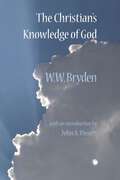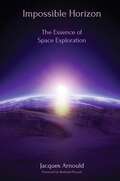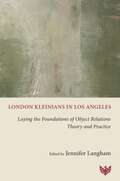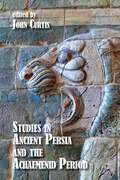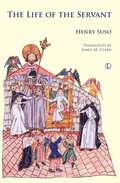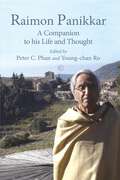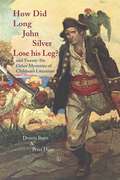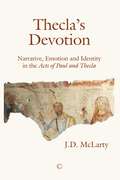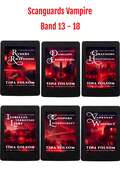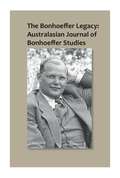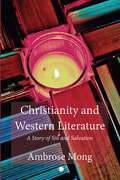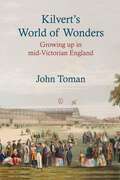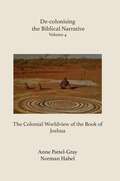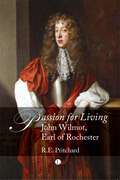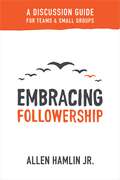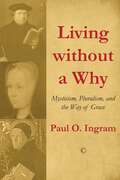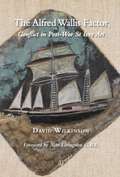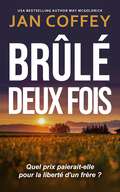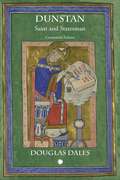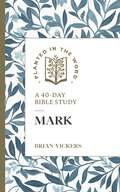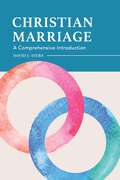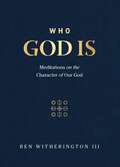- Table View
- List View
The Christian's Knowledge of God
by W. W. Bryden2012 will mark 60 years since the death of Walter Williamson Bryden. This reprint of his bold 1940 publication, featuring a new introduction by Dr John A. Vissers, Principal of Knox College, Toronto, celebrate the work of this eminent Presbyterian theologian. Best known for bringing Karl Barth to Canada, W.W. Bryden predicted the decline of Idealism and liberal theology in Protestantism at the start of the twentieth-century. When that crisis hit the Canadian Protestant Churches he was ready with this book. The Christian's Knowledge of God is a re-examination of Reformation teachings with particular focus on the revelation of God, by God through Christ. Bryden challenges his readers to question their blind acceptance of Christian doctrine and to reconsider what it means to have knowledge of the Divine and with it "the power to confront the world, no longer as those seeking, but as those having found God". Although the book concludes "Tempora mutantur, nos et mutamur in illis", we have not changed so much with the times as to make this book less relevant today than it was when first published. Indeed those seeking for knowledge of God today could do well to be reminded of Bryden's message.
Impossible Horizon: The Essence of Space Exploration
by Jacques ArnouldFor a long time what we now know as space was inaccessible to humans, not because it was at a height which was unattainable without the least astronautical technology or principles, but because of the cosmic and dualistic representation of reality. Humans were relegated to the centre, to a sort of ecesspiti of imperfection, alteration, incompleteness and finally death. Around them were crystal spheres which held the planets and starsoimmutable, eternal and perfectoa domain which was completely off-limits to humans, unless they had discarded their carnal envelope, either through a mystical experience or after death. It took a revolution, the Copernican Revolution, to shatter the celestial spheres and make them no longer forbidden territory. Galileo was one of the first revolutionaries: through his astronomical observations, he showed the Earth and the Sky were in fact made of the same fabric, the same material, and therefore belonged to the same world. Then followed Kepler and others. Centuries passed, and human conquered the air, and then space. Their feet touched the surface of the Moon and their wheels the surface of Mars. The Earth and the entire universe somehow became flat again with no folds, no curves, at least in appearance, to hide any dark corners. The horizon once again retreated out of reach taking with it perhaps the last dreams of exploration. The human imagination does not like horizons which are too flat, too clear; humanity needs to meet resistance, brakes, constraints to stop them in their tracks, to cross them and lead them, to new unknown territories. An impossible Horizon, writes Jacques Arnould in this work, but a horizon without which our adventures, our explorations would lose their savor and especially their meaning. We will then understand that even if the goal is never fully achieved, it is the quest that enriches us.i Bertrand Piccard. (Balloonist, aviator and psychiatrist, Bertrand Piccard is the first to complete a non-stop balloon flight around the globe, in a balloon named Breitling Orbiter 3. With Andre Borschberg, he is the initiator, chairman, and pilot of Solar Impulse, the first successful round-the-world solar powered flight)
London Kleinians in Los Angeles: Laying the Foundations of Object Relations Theory and Practice
by Jennifer LanghamIn 1968, Wilfred Bion and Albert Mason emigrated to Los Angeles at the invitation of a group of young analysts to teach and train local clinicians in the British object relations tradition. They were joined by Susanna Isaacs Elmhirst for a period. London Kleinians in Los Angeles is a colorful account of the early days of psychoanalysis in LA, punctuated by in-person presentations from the leading Kleinians of the day, including Hanna Segal, Herbert Rosenfeld, Donald Meltzer, and Wilfred Bion himself. Their unpublished lectures from the 1960s and 1970s appear in Part I. Part II features seminal papers by the founding fathers of the Psychoanalytic Center of California (PCC): James Gooch, James Grotstein, Arthur Malin, and Albert Mason, the group's leading spokesperson. PCC continues to function as a vital center of psychoanalytic training and education in the British object relations tradition. The unearthing of four unpublished contributions from four founding Kleinians is an incredible find for psychoanalysis and this book is highly recommended to all professionals and trainees in the field. Those with an interest in the history of psychoanalysis will find much to excite them.
Studies in Ancient Persia and the Achaemenid Period
by John CurtisJohn Curtis sees Christos Yannaras (b. 1935) as a philosopher and theologian whose refiguring, on the one hand, of Heidegger’s refusal to define being in ontic terms and, on the other, of Wittgenstein’s willingness to admit the inexpressible character of the mystical has led him to articulate a powerful vision of true human existence. This bold interpretation outlines the passage from an ontic ’mode of nature’ governed by necessity to a ’mode of self-transcendence and self-offering’ beyond the limitations of decay and death. In his native Greece, Yannaras revolutionised the way theology had been done for much of the twentieth century. This book examines the trajectory of Yannaras’ thought from his initial encounter with Heidegger’s philosophy to his formulation (via the tradition of the Greek Fathers) of a modern critical ontology. It is for both advanced students of philosophy and the growing scholarly audience interested in Yannaras’ work. Written in accessible language that does not compromise intellectual rigour, it is the only survey of the development of Yannaras’ philosophical thought as a whole.
Conflict and Agreement in the Church, Volume 1: Order and Disorder
by Jean RillietT.F. Torrance's Conflict and Agreement in the Church gathers together his most influential essays and articles on topics relating to ecumenism. Himself involved heavily in the ecumenical movement, he wrote that 'ours must be the task of learning together again how to confess, like the early Church, faith in Jesus Christ as Saviour and God in all its breadth and length and height and depth, and therefore in the overflowing love of God.' Out of this conviction grew a comprehensive doctrine of the Church 'in which our differences are lost sight of because they are destroyed from behind by a masterful faith in the Saviour of men.' In the first volume, Torrance presents a set of essays engaging theologically with different denominations, along with responses to particular problems facing the ecumenical project. In particular, writing after the third world conference on faith and order, he addresses the hopes and barriers it raised to closer ecumenical relations. Throughout, Torrance's acute awareness of contrasting theological principles establishes a firm basis for further progress, without obscuring the doctrinal and ecclesiological differences that remain. In the second volume, Torrance's thought on inter-denominational cooperation in light of the Church's mission is presented. He begins by suggesting that 'the lines of conflict and agreement in the Church coincide less and less with the frontiers of the historic communions'. This opens the door for greater union between those communion, but also exposes significant challenges to unity within them. Addressing the major debates on the sacraments of baptism and the Eucharist, along with the priesthood and biblical exegesis, Torrance proposes a constructive way forward sealed by 'reconciliation in the Body and Blood of Christ'.
The Life of the Servant
by Henry Suso'If this is not heaven, I do not know what heaven is, for all the suffering that can ever be put into words, could not enable anyone to earn such a reward and for ever possess it.' A central figure in Christian mystical literature, the Dominican Prior Henry Suso was the author of the seminal work The Life of the Servant. Transcribed by an enlightened amanuensis without his explicit consent, Suso began burning the manuscript until a heavenly missive from God decreed that the text should be spared further desecration. The remaining fragments of that conflagration are vividly resurrected in this volume, elegantly translated by James M. Clark. Suso's subjective account of the spiritual and invisible world, told in prose of unsurpassed poetic beauty, is reflective of the ardent spirituality of his devotion. Informed by severe mortifications, visions, ecstasies and revelations, this canonical text endures as a sublime cultural artefact. Resonating profoundly with contemporary concerns about austerity and materialism, this classic text of mysticism is once again accessible to a new generation of readers and to those existing admirers seeking to re-evaluate its many virtues.
Raimon Panikkar: A Companion to his Life and Thought
by Peter C. Phan Young-Chan RoRaimon Panikkar: A Companion to his Life and Thought is a guide to the life, work and thought of Raimon Panikkar, a self-professed Buddhist-Christian-Hindu philosopher and theologian. A man of deep and wide learning and an extremely prolific author, Panikkar is equally at home in various religious and cultural traditions and embodies in himself the ideals of intercultural, intrareligious, and interreligious dialogues. This book explicates Panikkar's basic vision of life as the harmonious rhythm of divinity, humanity, and the cosmos, which he terms cosmotheandrism, and shows how it permeates and illumines his articulations of the central Christian doctrines. Given the complexity and difficulty of Panikkar's thought this book is a welcome companion for a course on Panikkar and for a general reader who wishes to understand one of the most profound and orginal thinkers of our time.
How Did Long John Silver Lose his Leg: and Twenty-Six Other Mysteries of Children's Literature
by Dennis Butts Peter Hunt'How did Long John Silver Lose His Leg?' is a diverting tour through some of the bestloved classics of children's literature, addressing many of the unanswered questions that inspire intense speculation when the books are laid down. Could Bobbie's train really have stopped in time ('The Railway Children')? Did Beatrix Potter have the 'flu in 1909, and did this lead to a certain darkness in her work ('The Tale of Mr Tod')? Would the 'rugby football' played by Tom Brown be recognised by sportsmen today ('Tom Brown's Schooldays')? The authors speculate entertainingly and informatively on the anomalies and unexplained phenomena found in children's literature and, having established the cultural importance of children's books in the modern age, also consider the more serious issues raised by the genre. Why are we so defensive of the idyllic worlds presented in children's books? Why have some of our best-loved authors been outed as neglectful parents to their own children? Should we everseparate the book from its creator and appreciate the works of writers convicted of crimes against children? A treat for any enthusiast of children's literature, two of the most distinguished writers on the subject provide rich detail, witty explication, and serious food for thought.
Acknowledging the Divine Benefactor: The Second Letter of Peter
by Terrance Callan'Acknowledging the Divine Benefactor' is a socio-rhetorical interpretation of the Second Letter of Peter. Using multiple interpretive perspectives and emphasising the pictorial dimensions of 2 Peter, Terrance Callan shows that the letter makes the following argument: since Jesus Christ has given his followers benefits, including the promise of sharing in divine nature, they need to make a proper return for these benefits by living virtuously; and this in turn will enable them to receive the fulfilment ofthe promise. The occasion of the letter is that Peter's death is near. He writes so the addressees can remember his teaching after his death. The author expounds this teaching because some people do not await the future fulfilment of Christ's promises and so do not emphasise the need for virtuous living.
Thecla's Devotion: Narrative, Emotion and Identity in the Acts of Paul and Thecla
by Jd McLartySecond century apocryphal Christian texts are Christian fiction: they draw on the motifs of contemporary pagan stories of romance, travel and adventure to entertain their readers, but also to explore what it means to be Christian. The Thecla episodein the Apocryphal Acts of Paul recounts the conversion of a young pagan woman, her rejection of marriage, her narrow escapes from martyrdom and the end of her story as an independent, ascetic evangelist. In Thecla's Devotion, J.D. McLarty reads the Thecla episode against a paradigm pagan romance, Callirhoe: for both texts the passions are key to the unfolding of the plot - how are unruly emotions to be managed and controlled? The pagan would answer, 'through reason'. This study uses the portrayal of emotion within character and plot to explore the response of the Thecla episode to this key question for Christian identity formation.
Scanguards Vampire (Scanguards Vampire)
by Tina FolsomDieser Sammelband enthält: Band 13 – Ryders Rhapsodie Band 14 - Damians Eroberung Band 15 - Graysons Herausforderung Band 16 - Isabelles verbotene Liebe Band 17 - Coopers Leidenschaft Band 18 - Vanessas Wagemut Ryders Rhapsodie Als der Vampirhybride Ryder Giles beauftragt wird, Doktorandin und Bücherwurm Scarlet King zu beschützen, die von anderen Bodyguards als schwierig und manipulativ bezeichnet wird, ist er überzeugt, dass er es schaffen wird, die Wogen zu glätten. Schließlich ist er der kühle Kopf, den Scanguards als Leibwächter einsetzt, wenn alle anderen das Handtuch werfen. Allerdings weiß er nicht, dass Scarlet die heißblütige Verführerin ist, die ihm in der Nacht zuvor während ihrer wilden sexuellen Begegnung in einem Nachtclub einen falschen Namen gegeben hat – einer Begegnung, die sich als lebensverändernd für Ryder herausstellt. Damians Eroberung Als Vampir-Hybride, der nicht nur als Leibwächter für Scanguards arbeitet, sondern auch den Nachtclub Mezzanine leitet, hat Damian die Auswahl an schönen Frauen. Doch als die mollige Journalistin Naomi Sutton in das Büro des Nachtclubs einbricht, während sie Behauptungen angeblicher Blutrituale im Club nachgeht, regt sich Damians Blut wie nie zuvor. Doch wie kann er Naomi davon abhalten, seine Geheimnisse aufzudecken, wenn er nichts mehr will, als sie zu Seiner zu machen? Graysons Herausforderung Grayson Woodford, eigensinniger Erbe des Scanguards-Imperiums, ärgert sich über die Pläne seines Vaters Samson, ihn mit der Tochter eines alten Freundes zu verkuppeln. Die Vampirhybridin Monique Montague ist genauso sauer auf ihren Vater Cain, den Vampirkönig von Louisiana, weil dieser sie dazu überreden will, Grayson zu daten. Aus ihrer gemeinsamen Kindheit hat sie diesen als verwöhnt und arrogant in Erinnerung. Deshalb weigert sie sich, mit zur Silvesterparty zu kommen, bei der sie Grayson treffen soll, und reißt stattdessen in einer Bar einen Fremden auf, um mit diesem eine Nacht lang wilden Sex zu haben. Was sie nicht weiß, ist, dass der Fremde kein anderer als Grayson ist. Isabelles verbotene Liebe Als San Francisco von brutalen Morden aufgerüttelt wird, ist Scanguards sofort klar, dass die Beweise auf einen von ihnen hinweisen, den schroffen und äußerst privaten Türsteher und Vampir Orlando. Isabelle, die Hybridentochter von Samson und Delilah, versucht Orlandos Unschuld zu beweisen. Doch eine Enthüllung über Taten aus Orlandos Vergangenheit erschüttert ihr Vertrauen in ihn, während er versucht, sie wegzustoßen, aus Angst, dass sich die Vergangenheit wiederholen und ihn erneut allem berauben könnte, was er liebt. Coopers Leidenschaft Die eigensinnige Anita Diaz, Sheriff's Deputy in einer Kleinstadt in Nevada, folgt der Spur eines Serienmörders, der den amerikanischen Westen unsicher macht, und landet in San Francisco, wo der Scanguards-Ermittler und Vampir-Hybride Cooper Montgomery dem Mordfall einer unbekannten Frau nachgeht. Als sich ihre Wege kreuzen, klicken Handschellen, Köpfe stoßen aneinander und die Funken fliegen. Sie beschließen gemeinsam, den Mörder zu jagen, und Cooper weiß, dass Anita irgendwann erkennen wird, dass der Serienmörder, der ausgeblutete Leichen hinterlässt, ein Vampir ist – und dass Cooper und seine Freunde und Familie auch Vampire sind. Vanessas Wagemut Als Vanessa Giles, Community Outreach Managerin bei Scanguards, eine Prostituierte vor einem abtrünnigen Vampir rettet, kreuzt sie dabei den Weg des mysteriösen menschlichen Internetunternehmers Cole Whitlock. Er war nach San Francisco gezogen, um ein Heilmittel für sein körperliches Leiden zu suchen, von dem er niemandem etwas verraten darf, am allerwenigsten Vanessa, zu der er sich unerklärlicherweise hingezogen fühlt, obwohl er sie für eine Escort-Dame hält.
The Bonhoeffer Legacy: Australasian Jornal of Bonhoeffer Studies
by Terence Lovat1. Bonhoeffer and Biblical Interpretation: The Early Years
Christianity and Western Literature: A Story of Sin and Salvation
by Ambrose MongSome of the greatest works of Western literature have been inspired or influenced by powerful Christian themes. In this fresh evaluation of this relationship and its development over the last two millennia, Ambrose Mong studies a series of authors representative of the changing epochs. Augustine, Dante and Milton all wrote to serve the needs of the Christian community, and combine their religious themes with scholarly excellence. Meanwhile Shakespeare's plays and Coleridge's The Rime of the Ancient Mariner, though not specific to the Christian faith, nevertheless betray the dominant Christian values and imagery of their time. Finally, in Dostoevsky's The Brothers Karamazov and Greene's The Power and the Glory, Christianity is put under scrutiny, reflecting the increasing insecurity of its place in society. Throughout, Mong also shows that the themes in these works are to a certain extent universal. Creation, sin, suffering and forgiveness are perennial human concerns, beyond the exclusive purview of Christianity, and these texts serve to challenge Christian assumptions as much as they are influenced by them. Always thorough and sensitive to the unique context of each writer, Mong's analysis provides an important grounding in the way Western literature has shaped and been shaped by the religion of its day.
Kilvert's World of Wonders: Growing up in mid-Victorian England
by John TomanKilvert's World of Wonders takes a fresh look at the Victorian era, one that does not turn away from the smoke stacks and crowded streets of popular imagining, but which sees them from the distance of the rural countryside. Though a countryman and lover of country ways, here the well know diarist is shown to be deeply stirred by what he saw as a society being changed and improved by science, technology, and by the liberal, enlightened ideas that were starting to circulate. The social changes seen by Kilvert resonated with the vision of progress that was imbued in him by his Victorian upbringing, and as a result his diaries can be seen as a response to these changes and not, as previous Kilvert scholarship suggests, as a simple record of country life. Toman's new work goes beyond the biographical and social realities of Kilvert's family by comparing them to almost twenty other middle-class families in order to show common factors in the familial experience of a rapidly changing society. At the heart of this re-evaluation of Kilvert's life and times is the theme of Wonder, various aspects of which are explored throughout. Away from the rapidly growing urban centres the effects of industrialisation are seen in a surprisingly positive light by Francis Kilvert, a fervent Christian coming to terms with the encroachments that science, scepticism and secularism were making upon religious faith and yet seeing all around him a 'world of wonders'.
De-colonising the Biblical Narrative: The Colonial Worldview of the Book of Joshua
by Anne Pattel-Gray and Norman HabelVolume Four in the De-colonising the Biblical Narrative Series is dedicated to those First Nations Australia peoples who were encouraged who were informed by invading colonists, that Australia or other lands, was The Promised Land for the colonials, like the Land of Canaan, colonised by Joshua, in the name of the Colonial God YHWH whose merciless techniques, are outlined, by a Colonial Narrator in the Book of Joshua. The true message of The Book of Joshua has long been hidden. In Sunday School, in church sermons, in seminaries or in most interpretations of this book, Joshua has been viewed as a hero of a great God who enabled his people to escape from Egypt and to settle in the Promised Land. The colourful Crossing of the Jordan, the spectacular Fall of Jericho and the Sun Standing Still were viewed as amazing portraits of how the God of Israel enabled Israel to enjoy entering The Promised Land. There is only one way First Nations people can interpret Joshua but from a colonising point of view, as it is clear the colonial God favours one race of people over that of another. Colonists have over the centuries used the Book of Joshua as the bases for their justification to invade, colonise, steal lands, massacre First Nations people and enslave them.
Passion For Living: John Wilmot, Earl of Rochester
by R E PritchardJohn Wilmot, Earl of Rochester (1647-1680), has long been notorious as one of the most entertaining, extravagant and scandalous members of Charles II's court. He was also the most brilliant, witty and insightful satirist and lyric poet of his time, limited only by his early death caused by venereal disease and alcoholism. Passion for Living provides a full discussion of his life and writings, set in the context of his Times - the licentious court of Charles II and his mistresses, the Dutch warsand the so-called Popish Plot - together with close readings and analyses of his love lyrics, bawdy songs and shrewd satires, related to the life of his contemporaries, such as Thomas Hobbes, Samuel Butler and John Dryden. This informative and readable study will be of interest to both the general reader and the student.
Embracing Followership: A Discussion Guide for Teams & Small Groups
by Allen Hamlin Jr.We live in a leader-centric culture. But what if leadership isn't our goal? Can we use our skills to perform with excellence—as followers? In Embracing Followership, Allen Hamlin Jr. showed that you don't need to be a leader to make a difference. In this 16-part study guide to the book, you'll discover what following well looks like in your own life—unpacking key themes from Embracing Followership and looking to role models in the Bible for guidance on how to thrive as a follower. Additional discussion questions will also spark conversation among leaders and followers walking through the guide in a group setting. Embrace your role as a follower more fully with the Embracing Followership discussion guide!
Living without a Why: Mysticism, Pluralism, and the Way of Grace
by Paul O IngramIn this book Paul O. Ingram adds his voice to a long list of writers seeking to relate Christian tradition to the hard realities of this post-Christian age of religious and secular pluralism. As a Lutheran, Ingram thinks grace flows over this universe like a waterfall. So he brings Christian mystical theology into a discussion of the meaning of grace. Alfred North Whitehead's philosophical vision provides a language that serves as a hermeneutical bridge by which historians of religions can interpret the teachings and practices of religious Ways other than their own without falsification, and by which theologians can appropriate history-of-religions research as a means of helping Christians advance in their own faith journeys. The purpose of the journey of faith is what Whitehead called creative transformation. The contemporary theological tradition that has most systematically and coherently followed Whitehead's lead in its reflection on non-Christian Ways is process theology,which is perhaps the only liberal or progressive theological movement now active in the twenty-first century.
Ángel de Skye (La Familia Macpherson)
by Jan Coffey May McGoldrickGanador del Medallón Holt al Mejor Romance Histórico Desde las costas azotadas por el viento de Escocia hasta las cortes más lujosas de Europa, Ángel de Skye nos sumerge en una épica historia de amor, secretos y traición en los turbulentos días del reinado de Henry VIII. Fiona, una joven con el cabello como fuego y un pasado borrado por el tiempo, ha sido criada en un monasterio de la isla de Skye sin recuerdos de su linaje. Pero cuando el destino la pone en el camino del guerrero Alec Macpherson, un hombre leal al trono escocés y marcado por la guerra, su mundo da un vuelco. Alec está dispuesto a protegerla con su vida. Pero Fiona guarda un secreto que ni ella misma comprende del todo: un recuerdo enterrado que podría revelar al asesino de su madre y desestabilizar el futuro de Escocia. Entre batallas, pasiones y conspiraciones, Alec y Fiona deberán decidir si su amor puede sobrevivir en un mundo donde la verdad puede ser tan peligrosa como una espada. Una novela inolvidable de pasión, coraje y redención — donde el amor no solamente salva, sino que también desafía a reyes.
The Alfred Wallis Factor: Conflict in Post-War St Ives Art
by David WilkinsonSince his death in 1942, St Ives has become marinated in the spirit of the naive painter, Alfred Wallis. Naum Gabo, the Russian Constructivist, felt that Wallis's gift as an artist was that he never knew he was one. His unconventional approach and the innocence of his personal method of making art marked Alfred Wallis, even after his death, as a crucial figure in the modernist movement. The art scene in St Ives during World War II is depicted vividly in The Alfred Wallis Factor which illustrates the birth of modernism in the small fishing port in the far south-west of England. With dominant personalities like Sven Berlin, Ben Nicholson, Barbara Hepworth, Adrian Stokes, Bernard Leach, Terry Frost, Peter Lanyon, Wilhelmina Barns-Graham and Patrick Heron, it was inevitable that personal relationships would both form and fracture. Though causes would range from the banal to the bizarre, David Wilkinson never loses focus on the high stakes for which these characters were playing: the creation of their work, and reputations, of lasting significance. Their passion was strong and their ambition even stronger. The Alfred Wallis Factor tells the story of this extraordinary painter's long-lasting influence on - and beyond - modernism: David Wilkinson expounds the events around and following the artist's death, assessing the roles of friends and rivals in making Alfred Wallis a benchmark of modern British art. The Alfred Wallis Factor is a comprehensive examination of a troubled era, in which life met war and changed the destiny of the art world.
Brûlé Deux Fois
by Jan Coffey May McGoldrickLa peine de mort - un verdict unanime contre Ted Hardy pour les meurtres de sa femme, Marilyn, et de ses deux jeunes filles. Stonybrook se réjouit. Il est temps de punir cette famille maudite, de l'enfermer à jamais. Les Hardy n'ont-ils pas toujours été la honte de la ville ? Déjà, le père, une vingtaine d'années plus tôt, avait tué sa femme avant de se suicider... C'est dans ce climat de préjugés que Léa Hardy revient à Stonybrook. Léa sait que son frère est innocent des crimes dont on l'accuse, tout comme elle sait qu'il aimait ses enfants et que, malgré son divorce en cours, il n'aurait jamais pu poignarder sa femme. Alors qui est le véritable meurtrier ? La réponse se trouve ici, dans la ville où elle a grandi. Une ville où, sous ses dehors charmants, se cache un monde de vieux secrets, d'âmes blessées et de cœurs maléfiques. Une ville capable du meilleur, mais aussi du pire. A PROPOS DE L'AUTEUR Sous ce pseudonyme se cache en réalité un couple, Jim et Nikoo McGoldrick. En quelques années, ils ont accumulé les nominations et les prix, grâce à leurs talents conjugués. Leurs auteurs favoris, de Jane Austen à Nora Roberts, témoignent de leur goût pour le suspense et l'atmosphère - deux veines qu'ils explorent à merveille dans leurs romans. Brûlé Deux Fois PRIX D'EXCELLENCE DAPHNE DU MAURIER Gagnant PRIX NATIONAL DU CHOIX DES LECTEURS FINALISTE FINALISTE DU PRIX RWA RITA
Dunstan: Saint and Statesman
by Douglas DalesSt Dunstan of Canterbury (909-88) was the central figure in the development of English church and society after the death of King Alfred. Douglas Dales traces Dunstan's life beginning with his education at the great monastery of Glastonbury of whichhe became abbot. He was a central figure at the court of the kings of Wessex but was banished, partly because of his hostility to the king's mistresses, and went to exile in Flanders. After his return he was appointed Archbishop of Canterbury. During the twenty-eight years of his primacy he carried out one of the major developments of the century, the reformation of the monasteries. This book aims to examine him not merely as a prelate and royal advisor, but to see other aspects of his life: his skills as a craftsman caused him to be adopted as the patron saint of goldsmiths; some of his work as calligrapher and artist survives to this day; the coronation service which he drew up still lies at the heart of this service for English monarchstoday; he was famed for his musical skills; above all, the sanctity of his name and the fame of his miracles kept Dunstan's memory alive. Douglas Dales' re-examination of the life and times of Dunstan sets his achievements against the social and religious background of the day, at a time when new forces were emerging that would shape the future of England and the English Church for centuries to come.
Mark: A 40-Day Bible Study (Planted in the Word)
by Brian Vickers"WHO DO YOU SAY THAT I AM?" — MARK 8:29 Jesus asked his disciples this question, and no question is more important. The Gospel of Mark answers by presenting Jesus as the king who suffered and gave his life for us and invited us to take up our cross and follow him. Mark: A 40-Day Bible Study is meditative, gospel-centered, practical, and prayerful. Over forty days, you will: Read and reflect on Mark's Gospel. Meditate on Jesus and the good news he brings. Pray through Mark's Gospel. Apply Mark's Gospel to your life. Planted in the Word: Bible studies for individuals or small groups. Each volume provides forty days of guided Bible study written by respected scholars for everyday Christians. Short enough to read in 15 minutes or less, each day includes: Reading and meditation on Scripture Reflection on how the text points to Christ Application of God's word to our lives Praying for God's help Suggestions for further study or discussion. Each volume includes a reading plan for group study.
Christian Marriage: A Comprehensive Introduction
by David AyersWhy should we care about marriage? There is a lot of confusion about the purpose of marriage todayâ€"outside the church as well as within it. Written by a distinguished Christian sociologist, Christian Marriage is a theologically rich, biblically robust, and sociologically informed treatise on the nature and value of marriage. Drawing on recent social science research, empirical data, and social history, Ayers paints a picture of marriage as an institution meant for human flourishing. Along the way, Ayers addresses such topics as Dating and selection of a spouse The importance of premarital counseling Sex and procreation Mentoring and supporting unmarried believers Divorce and remarriage And current controversies surrounding premarital sex and same-sex marriage. Though the book is academically and theologically informed, it is written with a pastoral heart. It seeks to provide a rich resource for pastors and counselors on a topic of supreme importance to a vibrant church and society.
Who God Is: Meditations on the Character of Our God
by Ben WitheringtonDo you know the character of our God--do you know who God is? What does it mean to say that God is love, light, life, and spirit? In Who God Is, world-renowned New Testament scholar Ben Witherington III explores the nature and character of the God of the Bible by focusing specifically on the nouns used to describe who God is. This rich exploration has its foundation in a deep reading of the biblical text. Reflecting on these descriptions of God gives us a fresh understanding of the beauty and uniqueness of the character of our God.
